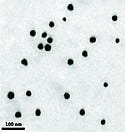Scientist Consults Tea Leaves to Fight Cancer
May 18, 2009
Originally Published MPMN May 2009
NEED TO KNOW
Scientist Consults Tea Leaves to Fight Cancer
|
A transmission electron microscopy image shows gold nanoparticles generated by phytochemicals in tea leaves. |
What do green manufacturing, nanoscience, and cancer have in common? Ask Kattesh V. Katti, a professor of radiology and physics at the University of Missouri (Columbia, MO; www.missouri.edu) and senior research scientist at the University of Missouri Research Reactor (www.murr.missouri.edu). Building on his research into soybeans to generate gold nanoparticles, a material that researchers believe can seek and destroy tumor cells without affecting healthy tissue, Katti is now enlisting the aid of tea leaves to combat cancer. Whether he is researching soybeans or tea leaves, Katti—together with colleagues Raghuraman Kannan, Kavita Katti, Ravi Shukla, Nripen Chanda, and Satish Nune—is determined to discover environmentally friendly forms of nanotechnology for next-generation cancer treatment.
The natural agents in tea leaves that help form gold nanoparticles are called phytochemicals, which include water-soluble catechins, theaflavins, and thearubigins. When immersed in water together with gold salts—ionic chemical compounds of gold— the phytochemicals reduce the gold salts to gold nanoparticles. “Phytochemicals play an important dual role in their overall interaction with gold salts,” remarks Katti. “Some of them interact with gold salts to chemically reduce the salts to gold nanoparticles, while others provide a robust coating around the gold nanoparticles to stabilize them against agglomeration.” Stability against agglomeration, according to Katti, is important because nanoparticles tend to aggregate and lose their nanoparticulate properties.
Many traditional agents for reducing gold salts to gold nanoparticles, including sodium borohydride and hydrazine, are toxic to plants and other living organisms. While another traditional agent, citrate salt, is derived from nontoxic citric acid, its large-scale production may involve toxic processes. In contrast, tea-based phytochemicals display good reduction-oxidation reaction (redox) potential, enabling them to produce gold nanoparticles in a clean, green process that involves simply mixing aqueous solutions of gold salts with tea leaves. Katti emphasizes that the process neither utilizes nor produces toxic chemicals.
Producing gold nanoparticles from tea leaves involves oxidation and reduction. Oxidation describes the process of electron loss, while reduction describes electron gain. Reducing substances transfer electrons to other substances, becoming oxidized in the process. Antioxidants in tea such as catechins are powerful reducing agents because they can donate electrons to gold salts and thus reduce gold salts to gold nanoparticles. Katti remarks, “The cocktail effect that combines the reduction power of phytochemicals present in tea makes this approach unique and provides an example of using mother nature in a nanotechnological revolution.”
Gold nanoparticles exhibit both diagnostic and therapeutic properties, Katti states. For example, gold nanoparticles coated with epigallocatechin gallate, a phytochemical found in tea leaves, have the potential to be used as diagnostic and therapeutic agents for multimodal cancer treatment. However, while the process for manufacturing gold nanoparticles from tea leaves and gold salts is nontoxic, scientists must also ensure that the nanoparticles themselves are safe for use in the human body. “In biomedical applications,” Katti emphasizes, “it is always desirable to minimize the toxicity of the chemical ingredients that constitute pharmaceuticals.” Fortunately, his research shows that the phytochemicals in tea form a nontoxic coating on gold nanoparticles, providing opportunities for their safe delivery and use in molecular imaging and therapy.
To capitalize on this potential, Katti has founded Greennano Co., a University of Missouri spin-off firm that focuses on commercializing nanoparticles made using green nanotechnology.
Copyright ©2009 Medical Product Manufacturing News
You May Also Like



